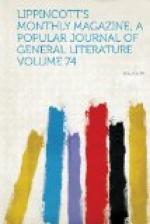Although I had never been dressed in the street, I yielded. It was a grand public holiday, and the sounds of festivity, which had floated into my chamber with the entrance of Hohenfels, were in full cadence outside. Everybody was pouring out to the city-gate, or returning from thence, where, in honor of some visit from the king of the Belgians and count and countess of Flanders, a festival was going on in imitation or rehearsal of the grand annual kermesse. These festivals, retained in Belgium with a delightful fidelity to the customs of antique Brabant, would fit the brush of Teniers better than the pen of a mere bewildered tourist. Still, I will try, copying principally from the reports of Charles (who contrives to peep at everything, with an interest whose amount is in ratio with the square of his distance from his master), to give a few features of the scene, which he spread in detail before the attentive Josephine during many an evening after.
[Illustration: Coals vs. Coats]
The principal fair-ground—though the occasion crammed the whole city with revelers—was just outside the gate. It was a veritable town in miniature, with a pattern of checker-board streets—Columbine street, Polichinelle street, Avenue des Parades, Place des Parades, Street of the Chanson, and the like. There were more than five hundred booths, all numbered—shops and restaurants. There were the Salon Curtius, the Menagerie Bidel, the Bal Mabille, the Cafe Bataclan, the American Tavern. From one of the little costumers’ shops, Charles—with a higher evincement of antiquarian taste than I should have expected—managed to bear away a pattern of wall-paper, which I afterward conferred on Mary Ashburleigh with great applause: it was Parisian of 1824, the epoch of Charles Dix, and was entirely covered with giraffes in honor of that puissant and elegant monarch. The above establishments were near the entrance, to the right.
At the left were more attractions: another menagerie, a heap of ostensible gold representing the five milliards paid by France, a gallery of astonished wax soldiers representing the Franco-Prussian war, a cook-shop with “mythologic” confectionery. Farther on, in the Theatre Casti, was exposed the “renowned buffoon Peppino,” breveted by His Majesty the “king of Egypt;” then came the Chiarini Theatre; then the Theatre Adrien Delille, an enchantingly pretty structure, where receptions were given by a little creature who should have sat under a microscope: she was “the Princess Felicia, aged thirteen, born at Clotat, near Marseilles, weighing three kilogrammes and measuring forty-six centimetres—a ravishing figure, admirably proportioned in her littleness and tout a fait sympathique!"




